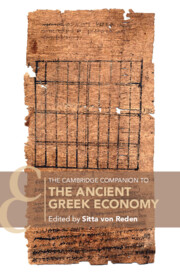76 results
5 - Hellenistic Economies
- from Part I - Diachronic Perspectives
-
-
- Book:
- The Cambridge Companion to the Ancient Greek Economy
- Published online:
- 21 July 2022
- Print publication:
- 04 August 2022, pp 61-74
-
- Chapter
- Export citation
Maps
-
- Book:
- The Cambridge Companion to the Ancient Greek Economy
- Published online:
- 21 July 2022
- Print publication:
- 04 August 2022, pp xix-xxiv
-
- Chapter
- Export citation
Part IV - Networks
-
- Book:
- The Cambridge Companion to the Ancient Greek Economy
- Published online:
- 21 July 2022
- Print publication:
- 04 August 2022, pp 279-328
-
- Chapter
- Export citation
Empirical Approaches
- from Part V - Performance
-
- Book:
- The Cambridge Companion to the Ancient Greek Economy
- Published online:
- 21 July 2022
- Print publication:
- 04 August 2022, pp 373-373
-
- Chapter
- Export citation
Maps
-
- Book:
- The Cambridge Companion to the Ancient Greek Economy
- Published online:
- 21 July 2022
- Print publication:
- 04 August 2022, pp viii-viii
-
- Chapter
- Export citation
Part I - Diachronic Perspectives
-
- Book:
- The Cambridge Companion to the Ancient Greek Economy
- Published online:
- 21 July 2022
- Print publication:
- 04 August 2022, pp 13-74
-
- Chapter
- Export citation
1 - Introduction
-
-
- Book:
- The Cambridge Companion to the Ancient Greek Economy
- Published online:
- 21 July 2022
- Print publication:
- 04 August 2022, pp 1-12
-
- Chapter
- Export citation
Theoretical Approaches
- from Part V - Performance
-
- Book:
- The Cambridge Companion to the Ancient Greek Economy
- Published online:
- 21 July 2022
- Print publication:
- 04 August 2022, pp 331-372
-
- Chapter
- Export citation
Copyright page
-
- Book:
- The Cambridge Companion to the Ancient Greek Economy
- Published online:
- 21 July 2022
- Print publication:
- 04 August 2022, pp iv-iv
-
- Chapter
- Export citation
Notes on the Contributors
-
- Book:
- The Cambridge Companion to the Ancient Greek Economy
- Published online:
- 21 July 2022
- Print publication:
- 04 August 2022, pp ix-xiii
-
- Chapter
- Export citation
Part V - Performance
-
- Book:
- The Cambridge Companion to the Ancient Greek Economy
- Published online:
- 21 July 2022
- Print publication:
- 04 August 2022, pp 329-420
-
- Chapter
- Export citation
Index
-
- Book:
- The Cambridge Companion to the Ancient Greek Economy
- Published online:
- 21 July 2022
- Print publication:
- 04 August 2022, pp 478-482
-
- Chapter
- Export citation
Abbreviations
-
- Book:
- The Cambridge Companion to the Ancient Greek Economy
- Published online:
- 21 July 2022
- Print publication:
- 04 August 2022, pp xiv-xviii
-
- Chapter
- Export citation
References
-
- Book:
- The Cambridge Companion to the Ancient Greek Economy
- Published online:
- 21 July 2022
- Print publication:
- 04 August 2022, pp 421-477
-
- Chapter
- Export citation
23 - New Institutional Economics, Economic Growth, and Institutional Change
- from Theoretical Approaches
-
-
- Book:
- The Cambridge Companion to the Ancient Greek Economy
- Published online:
- 21 July 2022
- Print publication:
- 04 August 2022, pp 347-359
-
- Chapter
- Export citation
Part II - Regional Perspectives
-
- Book:
- The Cambridge Companion to the Ancient Greek Economy
- Published online:
- 21 July 2022
- Print publication:
- 04 August 2022, pp 75-150
-
- Chapter
- Export citation
Part III - Structures and Processes
-
- Book:
- The Cambridge Companion to the Ancient Greek Economy
- Published online:
- 21 July 2022
- Print publication:
- 04 August 2022, pp 151-278
-
- Chapter
- Export citation
Contents
-
- Book:
- The Cambridge Companion to the Ancient Greek Economy
- Published online:
- 21 July 2022
- Print publication:
- 04 August 2022, pp v-vii
-
- Chapter
- Export citation

The Cambridge Companion to the Ancient Greek Economy
-
- Published online:
- 21 July 2022
- Print publication:
- 04 August 2022
Index
-
- Book:
- Comparing the Ptolemaic and Seleucid Empires
- Published online:
- 17 September 2021
- Print publication:
- 30 September 2021, pp 386-390
-
- Chapter
- Export citation



